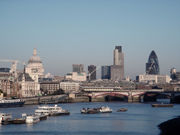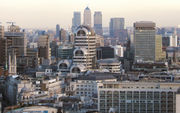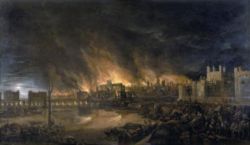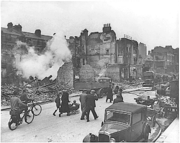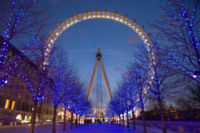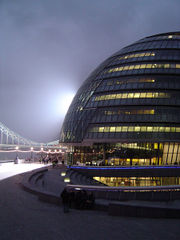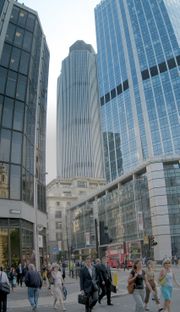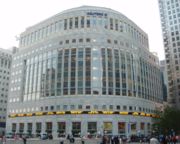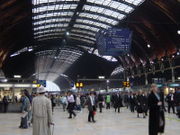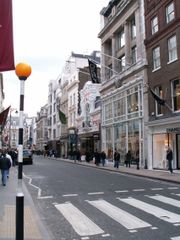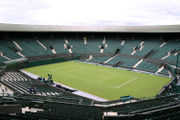London
2007 Schools Wikipedia Selection. Related subjects: Geography of Great Britain
| London | |
 The Palace of Westminster on the River Thames |
|
| Location | |
|---|---|
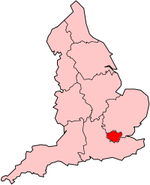 London region shown within England |
|
| Coordinates: | |
| Government | |
| Sovereign state: | United Kingdom |
| Constituent country: | England |
| Region: | London |
| Regional authority: | Greater London Authority |
| Regional assembly: | London Assembly |
| HQ: | City Hall |
| Mayor: | Ken Livingstone |
| Subdivisions | |
| Districts: | City & 32 London boroughs |
| UK Parliament: | 74 constituencies |
| London Assembly: | 14 constituencies |
| European Parliament: | London constituency |
| Geography | |
| City of London | |
| Area: | 2.6 km² (1.00 sq mi) |
| Population: | 9,200 (2005 est.) |
| Density: | 3,172/ km² |
| Greater London | |
| Area: | 1,579 km² (609 sq mi) |
| Population: | 7.5 million (2005 est.) |
| Density: | 4,761/ km² |
| Wider population | |
| Urban area: | 8.5 million |
| Metro area: | 12-14 million |
| Time Zone | |
| Standard: | GMT (UTC) |
| Summer: ( DST) | BST (UTC+1) |
| Website http://www.london.gov.uk |
|
London ( pronounced [ˈlʌndən]) is the capital city of England and the United Kingdom. An important settlement for around two millennia, London is today one of the world's most important business and financial centres, and its influence in politics, culture, education, entertainment, media, fashion, sport and the arts all contribute to its status as one of the key global cities.
London is the most populous city in the European Union with a population of 7.5 million and a metropolitan area population of between 12 and 14 million. Its population is very cosmopolitan, drawing from a diverse range of peoples, cultures and religions, speaking over 300 different languages. Residents of London are referred to as Londoners.
London is an international transport hub, with five international airports and a large port. It serves as the largest aviation hub in the world, and its principal airport, Heathrow, carries more international passengers than any other.
London is a major tourist destination - counting iconic landmarks such as the Houses of Parliament, Tower Bridge, the Tower of London, Westminster Abbey, Buckingham Palace and the London Eye amongst its many attractions, along with famous institutions such as the British Museum and the National Gallery.
Defining London
Area
Today, "London" usually refers to the area known as Greater London which is also the London region of England. At the heart of the conurbation is the small, ancient City of London which was historically the entirety of the city. Londoners generally refer to the City of London simply as "The City" or the "Square Mile". London's metropolitan area grew considerably during the Victorian era and again during the Interwar period with expansion halted in the 1940s by World War II and Green Belt legislation and has been largely static since.
The extent of the London postal district, Metropolitan Police District, local government area, London transport area, urban sprawl, coverage of the London telephone area code and metropolitan area have rarely been coterminous and are not currently. The area delimited by the orbital M25 motorway is sometimes used to define the "London area" and the Greater London boundary has been aligned to it in places. London is split for some purposes into Inner London and Outer London.
The co-ordinates of the nominal centre of London (traditionally considered to be the original Charing Cross, near the junction of Trafalgar Square and Whitehall) are approximately . The Romans may have marked the centre of Londinium with the London Stone in the City.
Status
The entire London urban area may be classed as a "city" using a geographical definition, but politically it is not so. Officially, London is a region containing two smaller cities within its built-up area: the City of London and the City of Westminster (see City status in the UK).
Unlike most capital cities, London's status as the capital of the UK has never been granted or confirmed officially — by statute or in written form. Its position as the capital has formed through constitutional convention, making its position as de facto capital a part of the UK's unwritten constitution.
Geography and climate
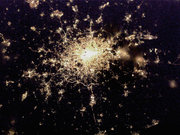
Topography and climate
Greater London covers an area of 609 square miles (1,579 km²), making it one of the world's largest cities by area. Its primary geographical feature is the Thames, a navigable river which crosses the city from the southwest to the east. The Thames Valley is a floodplain surrounded by gently rolling hills such as Parliament Hill and Primrose Hill. These hills presented no significant obstacle to the growth of London from its origins as a port on the north side of the river, and therefore London is roughly circular.
The Thames was once a much broader, shallower river with extensive marshlands. It has been extensively embanked, and many of its London tributaries now flow underground. The Thames is a tidal river, and London is vulnerable to flooding. The threat has increased over time due to a slow but continuous rise in high water level by the slow 'tilting' of Britain (up in the north and down in the south) caused by post-glacial rebound. In 1974, a decade of work began on the construction of the Thames Barrier across the Thames at Woolwich to deal with this threat, but a more substantial barrier further downstream may be necessary in the near future.
London has a temperate climate with regular but generally light precipitation throughout the year - London is in fact amongst the driest of Europe's capitals. The warmest month is July, with an average temperature range at Greenwich of 13.6 °C to 22.8 °C (56.5 to 73.0 °F). The coolest month is January, averaging 2.4 °C to 7.9 °C (35.6 to 46.2 °F). Average annual precipitation is 583.6 mm(22.98 in), with February on average the driest month. Snow is uncommon, particularly because heat from the urban area can make London 5 °C (9 °F) hotter than the surrounding areas in winter. London is in USDA Hardiness zone 9, and AHS Heat Zone 2.
| Month | Jan | Feb | Mar | Apr | May | Jun | Jul | Aug | Sep | Oct | Nov | Dec | |
|---|---|---|---|---|---|---|---|---|---|---|---|---|---|
| Avg high °C (°F) | 7.2 (45.0) | 7.6 (45.7) | 10.3 (50.5) | 13.0 (55.4) | 17.0 (62.6) | 20.3 (68.5) | 22.3 (72.1) | 21.9 (71.4) | 19.1 (66.4) | 15.2 (59.4) | 10.4 (50.7) | 8.2 (46.8) | |
| Avg low temperature °C (°F) | 2.4 (36.3) | 2.5 (36.5) | 3.8 (38.8) | 5.6 (42.1) | 8.7 (47.7) | 11.6 (52.9) | 13.7 (56.7) | 13.4 (56.1) | 11.4 (52.5) | 8.9 (48.0) | 5.1 (41.2) | 3.4 (38.1) | |
| Source: Worldweather.org | |||||||||||||
Districts
London's vast urban area is often described using a large set of district names (e.g. Bloomsbury, Mayfair, Whitechapel). These are for the most part informal designations which have become commonplace through tradition, each referring to a neighbourhood with its own distinctive character, but no official boundaries (often overlapping). One area of London which does have a strict definition is the City of London (usually just called The City), the largest financial district and central business district ( CBD) in Europe. The City has its own governance and boundaries, giving it a distinctive status as the only completely autonomous local authority in London. London's other financial hub is the Docklands area in the east of the city, dominated by the Canary Wharf complex, whilst many other businesses locate in the City of Westminster which is the home of the UK's national government.
The West End is London's main entertainment and shopping district, with locations such as Oxford Street, Leicester Square, Covent Garden and Piccadilly Circus acting as tourist magnets. The West London area is known for fashionable and expensive residential areas such as Notting Hill, Kensington and Chelsea — where some propeties can sell for £5,000,000 and above.
Meanwhile, the eastern side of London contains the East End — the area closest to the original Port of London, known for its high immigrant population, as well as for being one of the poorest areas in London. The surrounding East London area saw much of London's early industrial development; now, brownfield sites throughout the area are being redeveloped, including areas along the Thames (the Thames Gateway) and up the Lower Lea Valley, which is being developed into the Olympic Park for the 2012 Olympics. North London and South London are informal divisions of the capital made by the River Thames, although they can define varying areas.
Built environment
The density of London varies, with high employment density in the central area, high residential densities in inner London and lower densities in the suburbs. In the dense areas, most of the concentration is achieved with medium-rise buildings; high-rise buildings are fairly rare, even in employment centres. Thus, skyscrapers such as the City's "Gherkin", Tower 42 and One Canada Square stand out due to both their height and their relative rarity.
However, developments of tall buildings are encouraged in the London Plan, which will lead to the erection of many new skyscrapers over the next few years as London goes through a high-rise boom, particularly in the two financial centres, the City of London and Canary Wharf. The 72-storey, 310 m " Shard London Bridge" by London Bridge station, the 288 m Bishopsgate Tower and around 30 other skyscrapers over 150 m are either proposed or approved and could transform the city's skyline.
The buildings of London are a collection of different styles accumulated mostly over the time since the Great Fire in 1666. Although the City is characterised by 18th and 19th century architecture, there are a number of examples of more modern construction, such as the Lloyd's building and 30 St Mary Axe. London's focal point is the mid-19th century Trafalgar Square, marked with Nelson's Column and the site of major demonstrations and street events in the capital.
Parks and gardens
London has a number of open spaces situated throughout the city. The largest of these in the central area are the Royal Parks of Hyde Park and its neighbours Kensington Gardens and Holland Park Gardens at the western edge of central London, and Regent's Park on the northern edge. More central places are the smaller Royal Parks of Green Park and St. James's Park. Hyde Park in particular is popular for sports and sometimes hosts open-air concerts. A number of large parks outside the city centre are also notable, including the remaining Royal Parks of Greenwich Park to the south east, and Bushy Park and Richmond Park to the south west. Some more informal, semi-natural open spaces also exist, including the 791-acre Hampstead Heath of north London.
History
Early London
Although there is some evidence of scattered pre-Roman settlement in the area, the first major settlement was founded by the Romans in AD 43, following the Roman invasion of Britain. This settlement was called Londinium, commonly believed to be the origin of the present-day name, although a Celtic origin is also possible.
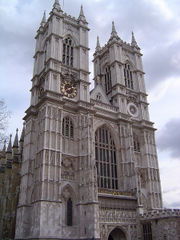
The first London lasted for just seventeen years. Around AD 61, the Iceni tribe of Celts led by Queen Boudica stormed London, burning it to the ground. The next, heavily-planned incarnation of the city prospered and superseded Colchester as the capital of the Roman province of Britannia in AD 100. At its height in the 2nd century AD, Roman London had a population of around 60,000. However, by the 3rd century AD, the city started a slow decline due to trouble in the Roman Empire, and by the 5th century AD, it was largely abandoned.
By 600 AD, the Anglo-Saxons had created a new settlement ( Lundenwic) about 1 km upstream from the old Roman city, around what is now Covent Garden. There was probably a harbour at the mouth of the River Fleet for fishing and trading, and this trading grew until disaster struck in 851 AD, when the city's defences were overcome by a massive Viking raid and it was razed to the ground. A Viking occupation twenty years later was short-lived, and Alfred the Great, the new King of England, established peace and moved the settlement within the defensive walls of the old Roman city (then called Lundenburgh). The original city became Ealdwīc ("old city"), a name surviving to the present day as Aldwych.
Subsequently, under the control of various English kings, London once again prospered as an international trading centre and political arena. However, Viking raids began again in the late 10th century, and reached a head in 1013 when they besieged the city under Danish King Canute and forced English King Ethelred the Unready to flee. In a retaliatory attack, Ethelred's army achieved victory by pulling down London Bridge with the Danish garrison on top, and English control was re-established.
Canute took control of the English throne in 1017, controlling the city and country until 1042, when his death resulted in a reversion to Anglo-Saxon control under his pious step-son Edward the Confessor, who re-founded Westminster Abbey and the adjacent Palace of Westminster. By this time, London had become the largest and most prosperous city in England, although the official seat of government was still at Winchester.
Norman and medieval London
Following a victory at the Battle of Hastings, William the Conqueror, the then Duke of Normandy, was crowned King of England in the newly-finished Westminster Abbey on Christmas Day 1066. William granted the citizens of London special privileges, whilst building a castle in the southeast corner of the city to keep them under control. This castle was expanded by later kings and is now known as the Tower of London, serving first as a royal residence and later as a prison.
In 1097, William II began the building of Westminster Hall, close by the abbey of the same name. The hall proved the basis of a new Palace of Westminster, the prime royal residence throughout the Middle Ages. Westminster became the seat of the royal court and government (persisting until the present day), whilst its distinct neighbour, the City of London, was a centre of trade and commerce and flourished under its own unique administration, the Corporation of London. Eventually, the adjacent cities grew together and formed the basis of modern central London, superseding Winchester as capital of England in the 12th century.
After the successful defeat of the Spanish Armada in 1588, political stability in England allowed London to grow further. In 1603, James VI of Scotland came to the throne of England, essentially uniting the two countries. His enactment of harsh anti-Catholic laws made him unpopular, and an assassination attempt was made on 5 November 1605 — the famous Gunpowder Plot.
Plague caused extensive problems for London in the early 17th century, culminating in the Great Plague in 1665-1666. This was the last major outbreak in Europe, possibly thanks to the disastrous fire of 1666. The Great Fire of London broke out in the original City and quickly swept through London's wooden buildings, destroying large swathes of the city (and killing off much of the disease-carrying rat population). Rebuilding took over ten years.
Rise of modern London
London's growth accelerated in the 18th century, and was the world's largest city from about 1831 to 1925 . This growth was aided from 1836 by London's first railways which put small countryside towns within easy reach of the city. The rail network expanded very rapidly, and caused these places to grow whilst London itself expanded into surrounding fields, merging with neighbouring settlements such as Kensington. Rising traffic congestion on city centre roads led to the creation of the world's first metro system — the London Underground — in 1863, driving yet further expansion and urbanisation.
London's local government system struggled to cope with the rapid growth, especially in providing the city with adequate infrastructure. Between 1855 and 1889, the Metropolitan Board of Works oversaw infrastructure expansion. It was then replaced by the County of London, overseen by the London County Council, London's first elected city-wide administration.
The Blitz and other bombing by the German Luftwaffe during World War II killed over 30,000 Londoners and flattened large tracts of housing and other buildings across London. The rebuilding during the 1950s, 1960s and 1970s was characterised by a wide range of architectural styles and has resulted in a lack of architectural unity that has become part of London's character. In 1965 London's political boundaries were expanded to take into account the growth of the urban area outside the County of London's borders. The expanded area was called Greater London and was administered by the Greater London Council.
In the decades following World War II, large-scale immigration from Commonwealth countries and beyond, transformed London into one of the most racially and culturally diverse cities in Europe. Integration of the new immigrants was not always smooth, with events such as the Brixton Riots in the 1980s.
An economic revival from the 1980s onwards re-established London's position as an eminent trading centre. However, as the seat of government and the most important city in the UK, it has been subjected to bouts of terrorism. IRA bombers sought to pressure the government into negotiations over Northern Ireland, frequently disrupting city activities with bomb threats — some of which were carried out — until their 1997 ceasefire. More recently, a series of coordinated bomb attacks were carried out by Islamic extremist suicide bombers on the public transport network on 7 July 2005 — just 24 hours after London was awarded the 2012 Summer Olympics.
Government
Local government
The administration of London takes place in two tiers — a city-wide, strategic tier and a local tier. City-wide administration is coordinated by the Greater London Authority (GLA), whilst local administration is carried out by 33 smaller districts.
The GLA is responsible for strategic planning, policing, the fire service, transport and economic development. It consists of two elected parts — the Mayor of London, who has executive powers, and the London Assembly, who scrutinise the Mayor's decisions and can accept or reject his budget proposals each year. The GLA is a recent organisation, having been set up in 2000 to replace the similar Greater London Council (GLC) which was abolished in 1986.
The current Mayor of London is Ken Livingstone, who is in his second term of office. He was elected in 2000 as an independent candidate and again in 2004 as a Labour candidate. Ken Livingstone was also the leader of the GLC when it was abolished.
The 33 local districts are the 32 London boroughs and the City of London. They are responsible for local services not overseen by the GLA, such as local planning, schools, social services, and refuse collection. The London boroughs each have a council which is elected every four years by local residents. The City of London does not have a conventional local authority, but is governed by the historic Corporation of London which is elected by both residents and businesses, and which has existed more or less unchanged since the Middle Ages.
The City of London also has its own police force: The City of London Police, which is independent of the Metropolitan Police Service which covers the rest of Greater London.
Health services in London are managed by the national government through the National Health Service, which is controlled and administered in London by five Strategic Health Authorities.
National government
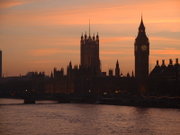
London is the home of the Government of the United Kingdom which is located around the Houses of Parliament in Westminster. Many government offices are located close to Parliament, particularly along Whitehall and including the Prime Minister's famous residence on Downing Street.
The British Parliament is often referred to as the "Mother of Parliaments" because it has been the model for most other parliamentary systems, and its Acts have created many other parliaments. Many nations with parliaments have to some degree emulated the British "three-tier" model. Most countries in Europe and the Commonwealth have similarly organized parliaments with a largely ceremonial head of state who formally opens and closes parliament, a large elected lower house and a smaller, upper house.
London is represented in the national Parliament by 74 Members of Parliament (MPs) who correspond to local parliamentary constituencies. For a list of London constituencies, see List of Parliamentary constituencies in Greater London. Of these 74 MPs, 44 are from the Labour Party, 21 are Conservatives, 8 are Liberal Democrats and one is from the RESPECT party.
Economy
London is a major centre for international business and commerce and is one of three "command centres" for the global economy (along with New York City and Tokyo).
As Europe's largest city economy, year-by-year, London's economy generates approximately 19% of the UK's GDP or £219 billion in 2005; whilst the entire London metropolitan area generates approximately 30% of UK GDP or £345 billion in 2005.
London shifted to a mostly service-based economy earlier than other European cities, particularly following the Second World War. London's relative success as a service industry and business centre can be attributed to a large array of factors: English becoming the new lingua franca; its former position as the capital of the British Empire; its close relationship with the US and various countries in Asia; English law being the most important and most used contract law in international business, the multi-cultural infrastructure (schools, places of worship, cultural and social organisations); relatively low taxes, particularly for foreigners (non-UK domiciled residents do not get taxed on their foreign earnings); a business friendly environment (e.g. in the City of London the local government is not elected by the resident population but instead by business - the City of London is a business democracy), good transport infrastructure, particularly its aviation industry and a deregulated economy with little intervention by the government.
Currently, over 85% (3.2 million) of the employed population of greater London works in the services industries. Another half a million employees resident in Greater London work in manufacturing and construction, almost equally divided between both.
London has five major business districts: the City, Westminster, Canary Wharf, Camden & Islington and Lambeth & Southwark.
| Business District | Office Space (m²) | Business Concentration |
|---|---|---|
| The City | 7,740,000 | finance, broking, insurance, legal |
| Westminster | 5,780,000 | head offices, real estate, private banking, hedge funds, government |
| Camden & Islington | 2,294,000 | creative industries, finance, design, art, fashion, architecture |
| Canary Wharf | 2,120,000 | banking, media, legal |
| Lambeth & Southwark | 1,780,000 | accountancy, consultancy, local government |
London's largest industry remains finance, and its financial exports make it a large contributor to the UK's balance of payments. The City is the largest financial and business centre in Europe, home to banks, brokers, insurers and legal and accounting firms. A second, smaller financial district is developing at Canary Wharf to the east of the City which includes the global headquarters of HSBC, Reuters, Barclays and many of the largest law firms in the world. London handled 31% of global currency transactions in 2005 — an average daily turnover of US$753 billion — with more US dollars traded in London than New York, and more Euros traded than in every other city in Europe combined.
More than half of the UK's top 100 listed companies (the FTSE 100) and over 100 of Europe's 500 largest companies are headquartered in central London. Over 70% of the FTSE 100 are located within London's metropolitan area, and 75% of Fortune 500 companies have offices in London.
Along with professional services, media companies are concentrated in London (see Media in London) and the media distribution industry is London's second most competitive sector. The BBC is a key employer, other broadcasters also have headquarters around the city. Many national newspapers are edited in London, having traditionally been associated with Fleet Street in the City, they are now primarily based around Canary Wharf. Soho is the centre of London's post-production industry.
Tourism is one of London's prime industries and employed the equivalent of 350,000 full-time workers in London in 2003, whilst annual expenditure by tourists is around £15bn. London is a popular destination for tourists, attracting 27 million overnight-stay visitors every year, second only to Paris.
From being the largest port in the world, the Port of London is now only the third-largest in the United Kingdom, handling 50 million tonnes of cargo each year. Most of this actually passes through Tilbury, outside the boundary of Greater London.
Demographics
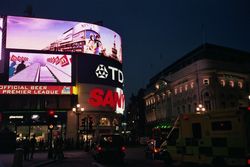
With increasing industrialisation, London's population grew rapidly throughout the 19th and early 20th centuries, and was the most populated city in the world until overtaken by New York in 1925. Its population peaked at 8,615,245 in 1939.
There were an estimated 7,517,700 people living in the Greater London area in mid- 2005. However, London's continuous urban area extends beyond the borders of Greater London and was home to 8,278,251 people at the 2001 UK census, whilst its wider metropolitan area has a population of between 12 and 14 million depending on the definition of that area . As per Eurostat, London is the most populous city and metropolitan area of the European Union .
- By Population of city (proper), London ranks 15th in the world.
- By Population of metropolitan area, London ranks 15th in the world.
- By Number of billionaires (United States Dollars), London ranks 4th in the world with 19.
- In terms of cost of living, London is the 1st most expensive city in the world to live in.
It is one of the most ethnically diverse cities in the industrialised world, with more than 300 languages spoken and 50 non-indigenous communities with a population of more than 10,000 living in London. The 2001 census showed that about 27% of London's population were born outside the UK, and about 29% were classified as non-white.
In terms of religion, London is historically dominated by Christianity, and has a large number of churches, particularly in the City. The famous St Paul's Cathedral in the City and Southwark Cathedral south of the river are Anglican administrative centres, whilst important national and royal ceremonies are shared between St Paul's and Westminster Abbey. The Abbey is not to be confused with nearby Westminster Cathedral, a relatively recent edifice which is the largest Roman Catholic cathedral in England and Wales. Despite all of this, observance is very low within the Anglican denomination and yet considerably higher among London's Roman Catholic and Christian Orthodox communities.
London is also home to sizeable Muslim, Hindu, Sikh, and Jewish communities. Many Muslims live in Tower Hamlets and Newham; the most important Muslim edifice is London Central Mosque on the edge of Regent's Park. London's large Hindu community is found in the north-western boroughs of Harrow and Brent, the latter of which contains one of Europe's largest Hindu temples, Neasden Temple. Sikh communities are located in East and West London, which is also home to one of the largest Sikh Temples in the world, outside India. The majority of British Jews live in London, with significant Jewish communities in Stamford Hill (the most Orthodox Jewish area outside New York and Israel) and Golders Green in North London.
Transport
Transport is one of the four areas of policy administered by the Mayor of London, but the mayor's financial control is limited. The public transport network, administered by Transport for London (TfL), is the most extensive in the world, but faces congestion and reliability issues, which a large investment programme is attempting to address, including £7 billion (€10 billion) of improvements planned for the Olympics.
Rail
The centrepiece of the public transport network is the London Underground, the oldest and largest metro system in the world, dating from 1863. The Metro system was home to the world's first underground electric line, the City & South London Railway, which began service in 1890. Nearly 1 billion journeys are made each year on the London Underground system. The Underground serves the central area and most suburbs to the north of the Thames, whilst those to the south are served by an extensive suburban rail network. Commuter and intercity railways generally do not cross the city, instead running into fourteen terminal stations scattered around its historic centre. The London bus network caters for most local journeys and carries even more passengers than the Underground. These internationally recognised buses are the trademark of London transport along-side black cabs and the underground.
- Metro systems by annual passenger ridership, London ranks 7th in the world, with 976 million passengers per year.
Air
London is an international transport hub, with five sizeable airports and a cross-channel rail service. Heathrow is the busiest airport in the world for international traffic; such traffic is also handled at Gatwick, whilst Stansted and Luton cater mostly for low-cost short-haul flights. London City, the smallest and most central airport, is focused on business travellers. Eurostar trains link London Waterloo station with Lille and Paris in France, and Brussels in Belgium.
Biggin Hill is often counted as London's sixth airport. However, this is not an international airport and handles mainly chartered aircraft.
- By annual passenger air traffic (2002 census), London ranks 1st in the world, with around 133,599,000 passengers using London Heathrow Airport, London Gatwick Airport, London Stansted Airport, London Luton Airport and London City Airport in the year 2005.
Road
Although the vast majority of journeys involving central London are made by public transport, travel in outer London is car-dominated. The inner ring road (around the city centre), the North and South Circular roads (in the suburbs) and an orbital motorway (the M25, outside the built-up area) circuit the city and are intersected by a number of busy radial routes — but very few motorways penetrate into inner London. A plan for a comprehensive network of motorways throughout the city (the Ringways Plan) was prepared in the 1960s but was mostly cancelled in the early 1970s due to vociferous objections from the population and the huge costs. In 2003, a congestion charge was introduced to reduce traffic volumes in the city centre. With a few exceptions, motorists are required to pay £8 per day to drive within a defined zone encompassing much of central London. Motorists who are residents in the defined zone can also buy a season pass which is renewed monthly.
Education
Home to a diverse range of universities, colleges and schools, London has a significant student population (about 378,000) and is a centre of research and development. Most primary and secondary schools in London follow the same system as the rest of England.
With 125,000 students, the University of London is the largest contact teaching university in the United Kingdom and in Europe. It comprises 20 colleges as well as several smaller institutes, each with a high degree of autonomy. Constituent colleges have their own admissions procedures, and are effectively universities in their own right, although all degrees are awarded by the University of London rather than the individual colleges. Its constituents include multi-disciplinary colleges such as UCL, King's and Queen Mary and more specialised institutions such as Imperial, the London School of Economics, SOAS, the Royal Academy of Music and the Institute of Education.
London's other universities, such as City University, London Metropolitan University, Middlesex University, UEL, the University of Westminster and London South Bank University, are not part of the University of London. Some were polytechnics until these were granted university status in 1992, and others which were founded much earlier.
London is home to a number of important museums and other institutions which are major tourist attractions as well as playing a research role. The Natural History Museum, Science Museum and Victoria and Albert Museum (dealing with fashion and design) are clustered in South Kensington's "museum quarter", whilst the British Museum houses historic artefacts from around the world. The British Library at St Pancras is the UK's national library, housing 150 million items. The city also houses extensive art collections, primarily in the National Gallery, Tate Britain and Tate Modern.
Society and culture
Leisure and entertainment
Within the City of Westminster, the entertainment district of the West End has its focus around Leicester Square, where London film premieres are held, and Piccadilly Circus, with its giant electronic advertisements. London's theatre district is here, as are many cinemas, bars, clubs and restaurants, including the city's Chinatown district, whilst just to the east is Covent Garden, an area housing speciality shops and London's " Avenue of Stars" which honours achievers in the entertainment industry.
London's busiest shopping area is Oxford Street, a mainstream shopping street nearly 2 km long. The adjoining Bond Street in Mayfair is a more upmarket location along with the Knightsbridge area - home to the Harrods department store - to the southwest. The districts of Knightsbridge ( Sloane Street), Mayfair (Bond Street, Brook Street), and Chelsea (King's Road) represent London's prestigious role in the world of fashion, being an international centre of fashion alongside Paris, Milan, New York and Tokyo. Furthermore, London has a number of markets, including Camden Market for fashions, Portobello Road for antiques and Borough Market for foods.
London offers a huge variety of cuisines as a result of its ethnically diverse population. Well-known gastronomic centres include the Bangladeshi restaurants of Brick Lane and the Chinese food of Chinatown. Soho offers a variety of relatively cheap international restaurants, whilst more upmarket restaurants are scattered around central London, with concentrations in Mayfair. Across the city, areas home to particular ethnic groups are often recognisable by restaurants, food shops and market stalls offering their local fare, and even the large supermarkets stock such items in areas with sizeable ethnic groups.
The Caribbean-descended community in Notting Hill in West London organises the colourful Notting Hill Carnival, Europe's biggest street carnival, every summer. The beginning of the year is celebrated with the relatively new New Year's Day Parade, whilst traditional parades include November's Lord Mayor's Show, a centuries-old event celebrating the annual appointment of a new Lord Mayor of the City of London with a procession along the streets of the City, and June's Trooping the Colour, a very formal military pageant to celebrate the (official) Queen's Birthday.
Literature and film
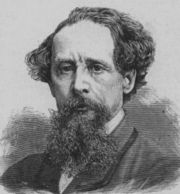
London has been the setting for many works of literature. Two writers closely associated with the city are the diarist Samuel Pepys, famous among other things for his eyewitness account of the Great Fire, and Charles Dickens, whose representation of a foggy, snowy, grimy London of street sweepers and pickpockets is a major influence on people's vision of early Victorian London. James Boswell's biographical Life of Johnson mostly takes place in London, and is the source of Johnson's famous aphorism: "When a man is tired of London, he is tired of life; for there is in London all that life can afford." The earlier (1722) A Journal of the Plague Year by Daniel Defoe is a fictionalisation of the events of the 1665 Great Plague. William Shakespeare spent a large part of his life living and working in London; his contemporary Ben Jonson was also based in London, and some of his work -- most notably his play The Alchemist -- was set in the city. Later important depictions of London from the 19th and early 20th centuries are the afore-mentioned Dickens novels, and Arthur Conan Doyle's famous Sherlock Holmes stories. The 1933 novel Down and Out in Paris and London by George Orwell describes life in poverty in both cities. A modern writer pervasively influenced by the city is Peter Ackroyd, in works such as London: The Biography, The Lambs of London and Hawksmoor. Along with Bloomsbury, the hilly area of Hampstead has traditionally been the literary heartland of London.
Traditionally, London has played a significant role in the film industry, and boasts major studios at Pinewood and Shepperton, both just outside West London, as well as an important special effects and post-production community. Many films have also used London as a location and have done much to shape international perceptions of the city. See main article London in film.
The city also hosts a number of performing arts schools, including the Central School of Speech and Drama, whose past students include Judi Dench and Laurence Olivier, the London Academy of Music and Dramatic Art (educators of Jim Broadbent and Donald Sutherland amongst others) and the prestigious Royal Academy of Dramatic Art (past students including Joan Collins and Roger Moore).
The London Film Festival is held in the city each October.
Music
London is one of the major music capitals in the world and is home to one of the five major global music corporations EMI. London and its surrounding Home Counties have spawned iconic and popular artists through the years, including The Who, The Rolling Stones, Pink Floyd, Led Zeppelin, David Bowie, Eric Clapton, Cream, Iron Maiden, The Yardbirds, Genesis, Elton John, Yes, Queen, The Clash, The Sex Pistols, Radiohead, Keane, Jamiroquai, Coldplay, Sophie Ellis Bextor, Robbie Williams and Bernard Butler. London's current scene for local live bands can be found in Camden and the West End. London is also home to the first and original Hard Rock Cafe and EMI's Abbey Road Studios. More recently, London has been the centre for the UK's thriving urban music scene, with artists like Dillinja ( Drum 'n' Bass / Jungle), So Solid Crew ( UK Garage), Dizzee Rascal ( Grime) and Roots Manuva ( UK Hip Hop) becoming popular.
Sport
London has hosted the Summer Olympics twice, in 1908 and 1948. In July 2005 London was chosen to host the Games in 2012, which will make it the first city in the world to host the Summer Olympics three times. London was also the host of the British Empire Games in 1934.
London's most popular sport (for both participants and spectators) is football. London has 12 League Football clubs, including six in the Premiership (Arsenal, Charlton Athletic, Chelsea, Fulham, Tottenham Hotspur and West Ham United) and a further six in the remaining three divisions ( Barnet, Brentford, Crystal Palace, Leyton Orient, Millwall and Queens Park Rangers), plus countless non-league and amateur football teams.
London has a unique place in the history of football. First, in the sixteenth century headmaster of St Paul's School Richard Mulcaster is credited with taking mob football and transforming it into organised and refereed team football in order to be beneficial for schoolboys. Second, London was home to Ebenezer Cobb Morley who was a founding member of the Football Association in 1862. In 1863, he wrote to Bell's Life newspaper proposing a governing body for football that led to the first meeting at the Freemason's Tavern in central London that created the Football Association, the English governing body of soccer and the first of its kind anywhere in the world. He wrote at his house in Barnes the first set of rules of true modern soccer that were adopted by the FA and spread all over the world. It is, therefore, true to say that Association football (soccer) was invented in London
London also has four rugby union teams in the Guinness Premiership ( London Irish, Saracens, Wasps and NEC Harlequins), although only the Harlequins play in London (all the other three now play outside Greater London), as well as a rugby league Super League club in Harlequins RL. London also has many famous other rugby union clubs in lower leagues, including Richmond F.C., Blackheath R.C., Rosslyn Park F.C. and Barnes R.F.C.
Wembley Stadium (which is currently being rebuilt) has traditionally been the home of the English national football team, and serves as the venue for the FA Cup final as well as rugby league's Challenge Cup final. Twickenham Stadium in west London is the national rugby union stadium.
Cricket in London centres on its two Test cricket grounds at Lord's (home of Middlesex CC) in St John's Wood, and The Oval (home of Surrey CC) in Kennington.
One of London's most well-known annual sports competitions is the Wimbledon Tennis Championships, held at the All England Club in the south-western suburb of Wimbledon. Other key events are the annual mass-participation London Marathon which sees some 35,000 runners attempt a 42 km course around the city, and the Oxford vs. Cambridge Boat Race on the River Thames between Putney and Mortlake.
Twinnings
London has " sister city" agreements with the following cities:
 New York City, USA since 2001
New York City, USA since 2001 Moscow, Russia
Moscow, Russia Berlin, Germany (since 2000)
Berlin, Germany (since 2000) Beijing, China since 2006
Beijing, China since 2006 Tokyo, Japan since 2006
Tokyo, Japan since 2006 Bucharest, Romania (since 2002)
Bucharest, Romania (since 2002) Paris, France (since 2001)
Paris, France (since 2001)
